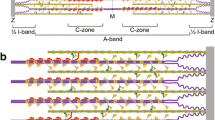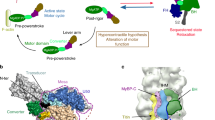Abstract
This review proposes a link between the hypertrophic (HCM) and restrictive cardiomyopathies caused by mutations in several sarcomeric thin filament proteins, and the open state of the three-state muscle regulation theory. The three characteristics of various muscle systems reconstituted from HCM mutated proteins (increased Ca2+-sensitivity, increased basal activity in the absence of Ca2+, and decreased cooperativity) can be explained by the contribution of a myosin-induced open state (M−), which elevates the basal activity and competes with the normal Ca2+-activated pathway. A model based on the three-state theory of regulation, shows how a change in the closed/blocked equilibrium caused by a mutation that weakens the binding of troponin I to tropomyosin-actin can produce the characteristics of HCM. This review also shows that in the M− state, Ca2+ can shift the closed–open equilibrium of the N-terminal hydrophobic region of troponin C without affecting activity.




Similar content being viewed by others
References
Bai F, Weis A, Takeda AK, Chase PB, Kawai M (2011) Enhanced active cross-bridges during diastole: molecular pathogenesis of tropomyosin’s HCM mutations. Biophys J 100(4):1014–1023. doi:10.1016/j.bpj.2011.01.001
Boussouf SE, Maytum R, Jaquet K, Geeves MA (2007) Role of tropomyosin isoforms in the calcium sensitivity of striated muscle thin filaments. J Muscle Res Cell Motil 28(1):49–58. doi:10.1007/s10974-007-9103-z
Chang AN, Harada K, Ackerman MJ, Potter JD (2005) Functional consequences of hypertrophic and dilated cardiomyopathy-causing mutations in alpha-tropomyosin. J Biol Chem 280(40):34343–34349. doi:10.1074/jbc.M505014200
Dong WJ, Cheung HC (1996) Calcium-induced conformational change in cardiac troponin C studied by fluorescence probes attached to Cys-84. Biochim Biophys Acta 1295(2):139–146
Dong WJ, Xing J, Villain M, Hellinger M, Robinson JM, Chandra M, Solaro RJ, Umeda PK, Cheung HC (1999) Conformation of the regulatory domain of cardiac muscle troponin C in its complex with cardiac troponin I. J Biol Chem 274(44):31382–31390
Dong WJ, Jayasundar JJ, An J, Xing J, Cheung HC (2007) Effects of PKA phosphorylation of cardiac troponin I and strong crossbridge on conformational transitions of the N-domain of cardiac troponin C in regulated thin filaments. Biochemistry 46(34):9752–9761. doi:10.1021/bi700574n
Elliott K, Watkins H, Redwood CS (2000) Altered regulatory properties of human cardiac troponin I mutants that cause hypertrophic cardiomyopathy. J Biol Chem 275(29):22069–22074
Fitzsimons DP, Patel JR, Moss RL (2001) Cross-bridge interaction kinetics in rat myocardium are accelerated by strong binding of myosin to the thin filament. J Physiol 530(Pt 2):263–272
Galinska-Rakoczy A, Engel P, Xu C, Jung H, Craig R, Tobacman LS, Lehman W (2008) Structural basis for the regulation of muscle contraction by troponin and tropomyosin. J Mol Biol 379(5):929–935. doi:10.1016/j.jmb.2008.04.062
Geeves MA, Lehrer SS (1994) Dynamics of the muscle thin filament regulatory switch: the size of the cooperative unit. Biophys J 67(1):273–282. doi:10.1016/S0006-3495(94)80478-3
Geeves MA, Chai M, Lehrer SS (2000) Inhibition of actin-myosin subfragment 1 ATPase activity by troponin I and IC: relationship to the thin filament states of muscle. Biochemistry 39(31):9345–9350
Golitsina N, An Y, Greenfield NJ, Thierfelder L, Iizuka K, Seidman JG, Seidman CE, Lehrer SS, Hitchcock-DeGregori SE (1997) Effects of two familial hypertrophic cardiomyopathy-causing mutations on alpha-tropomyosin structure and function. Biochemistry 36(15):4637–4642. doi:10.1021/bi962970y
Golitsina N, An Y, Greenfield NJ, Thierfelder L, Iizuka K, Seidman JG, Seidman CE, Lehrer SS, Hitchcock-DeGregori SE (1999) Effects of two familial hypertrophic cardiomyopathy-causing mutations on alpha-tropomyosin structure and function. Biochemistry 38(12):3850
Gomes AV, Barnes JA, Harada K, Potter JD (2004) Role of troponin T in disease. Mol Cell Biochem 263(1–2):115–129
Gomes AV, Liang J, Potter JD (2005) Mutations in human cardiac troponin I that are associated with restrictive cardiomyopathy affect basal ATPase activity and the calcium sensitivity of force development. J Biol Chem 280(35):30909–30915. doi:10.1074/jbc.M500287200
Jagatheesan G, Rajan S, Petrashevskaya N, Schwartz A, Boivin GP, Arteaga GM, Solaro RJ, Liggett SB, Wieczorek DF (2007) Rescue of tropomyosin-induced familial hypertrophic cardiomyopathy mice by transgenesis. Am J Physiol Heart Circ Physiol 293(2):H949–H958
Janco M, Kalyva A, Scellini B, Piroddi N, Tesi C, Poggesi C, Geeves MA (2012) α-Tropomyosin with a D175N or E180G mutation in only one chain differs from tropomyosin with mutations in both chains. Biochemistry 51(49):9880–9890. doi:10.1021/bi301323n
Kobayashi T, Solaro RJ (2006) Increased Ca2+ affinity of cardiac thin filaments reconstituted with cardiomyopathy-related mutant cardiac troponin I. J Biol Chem 281(19):13471–13477
Kremneva E, Boussouf S, Nikolaeva O, Maytum R, Geeves MA, Levitsky DI (2004) Effects of two familial hypertrophic cardiomyopathy mutations in alpha-tropomyosin, Asp175Asn and Glu180Gly, on the thermal unfolding of actin-bound tropomyosin. Biophys J 87(6):3922–3933. doi:10.1529/biophysj.104.048793
Lang R, Gomes AV, Zhao J, Housmans PR, Miller T, Potter JD (2002) Functional analysis of a troponin I (R145G) mutation associated with familial hypertrophic cardiomyopathy. J Biol Chem 277(14):11670–11678
Lehman W, Orzechowski M, Li XE, Fischer S, Raunser S (2013) Gestalt-binding of tropomyosin on actin during thin filament activation. J Muscle Res Cell Motil. doi:10.1007/s10974-013-9342-0
Lehrer SS (2011) The 3-state model of muscle regulation revisited: is a fourth state involved? J Muscle Res Cell Motil 32(3):203–208. doi:10.1007/s10974-011-9263-8
Li MX, Spyracopoulos L, Sykes BD (1999) Binding of cardiac troponin-I147-163 induces a structural opening in human cardiac troponin-C. Biochemistry 38(26):8289–8298. doi:10.1021/bi9901679
Liao R, Wang CK, Cheung HC (1994) Coupling of calcium to the interaction of troponin I with troponin C from cardiac muscle. Biochemistry 33(42):12729–12734
Ly S, Lehrer SS (2012) Long-range effects of familial hypertrophic cardiomyopathy mutations E180G and D175N on the properties of tropomyosin. Biochemistry 51(32):6413–6420. doi:10.1021/bi3006835
Marston SB (2011) How do mutations in contractile proteins cause the primary familial cardiomyopathies? J Cardiovasc Transl Res 4(3):245–255. doi:10.1007/s12265-011-9266-2
Maytum R, Westerdorf B, Jaquet K, Geeves MA (2003) Differential regulation of the actomyosin interaction by skeletal and cardiac troponin isoforms. J Biol Chem 278(9):6696–6701
McKillop DFA, Geeves MA (1993) Regulation of the interaction between actin and myosin subfragment 1: evidence for three states of the thin filament. Biohys J 65:693–701
Moss RL, Razumova M, Fitzsimons DP (2004) Myosin crossbridge activation of cardiac thin filaments: implications for myocardial function in health and disease. Circ Res 94(10):1290–1300
Mudalige WA, Tao TC, Lehrer SS (2009) Ca2+-dependent photocrosslinking of tropomyosin residue 146 to residues 157–163 in the C-terminal domain of troponin I in reconstituted skeletal muscle thin filaments. J Mol Biol 389(3):575–583. doi:10.1016/j.jmb.2009.04.027
Murakami K, Yumoto F, Ohki SY, Yasunaga T, Tanokura M, Wakabayashi T (2005) Structural basis for Ca2+-regulated muscle relaxation at interaction sites of troponin with actin and tropomyosin. J Mol Biol 352(1):178–201. doi:10.1016/j.jmb.2005.06.067
Ohtsuki I, Morimoto S (2008) Troponin: regulatory function and disorders. Biochem Biophys Res Commun 369(1):62–73. doi:10.1016/j.bbrc.2007.11.187
Parvatiyar MS, Pinto JR, Dweck D, Potter JD (2010) Cardiac troponin mutations and restrictive cardiomyopathy. J Biomed Biotechnol 2010:350706. doi:10.1155/2010/350706
Parvatiyar MS, Landstrom AP, Figueiredo-Freitas C, Potter JD, Ackerman MJ, Pinto JR (2012) A mutation in TNNC1-encoded cardiac troponin C, TNNC1-A31S, predisposes to hypertrophic cardiomyopathy and ventricular fibrillation. J Biol Chem 287(38):31845–31855. doi:10.1074/jbc.M112.377713
Pinto JR, Parvatiyar MS, Jones MA, Liang J, Potter JD (2008) A troponin T mutation that causes infantile restrictive cardiomyopathy increases Ca2+ sensitivity of force development and impairs the inhibitory properties of troponin. J Biol Chem 283(4):2156–2166. doi:10.1074/jbc.M707066200
Pinto JR, Parvatiyar MS, Jones MA, Liang J, Ackerman MJ, Potter JD (2009) A functional and structural study of troponin C mutations related to hypertrophic cardiomyopathy. J Biol Chem 284(28):19090–19100. doi:10.1074/jbc.M109.007021
Pinto JR, Reynaldo DP, Parvatiyar MS, Dweck D, Liang J, Jones MA, Sorenson MM, Potter JD (2010) Strong cross-bridges potentiate the Ca(2+) affinity changes produced by hypertrophic cardiomyopathy cardiac troponin C mutants in myofilaments: a fast kinetic approach. J Biol Chem 286(2):1005–1013. doi:10.1074/jbc.M110.168583
Redwood C, Robinson P (2013) Alpha-tropomyosin mutations in inherited cardiomyopathies. J Muscle Res Cell Motil 34(3–4):285–294. doi:10.1007/s10974-013-9358-5
Rieck DC, Li KL, Ouyang Y, Solaro RJ, Dong WJ (2013) Structural basis for the in situ Ca(2+) sensitization of cardiac troponin C by positive feedback from force-generating myosin cross-bridges. Arch Biochem Biophys 537(2):198–209. doi:10.1016/j.abb.2013.07.013
Robinson JM, Dong WJ, Xing J, Cheung HC (2004) Switching of troponin I: Ca(2+) and myosin-induced activation of heart muscle. J Mol Biol 340(2):295–305. doi:10.1016/j.jmb.2004.04.046
Robinson P, Griffiths PJ, Watkins H, Redwood CS (2007) Dilated and hypertrophic cardiomyopathy mutations in troponin and {alpha}-tropomyosin have opposing effects on the calcium affinity of cardiac thin filaments. Circ Res 101(12):1266–1273
Sommese RF, Sung J, Nag S, Sutton S, Deacon JC, Choe E, Leinwand LA, Ruppel K, Spudich JA (2013) Molecular consequences of the R453C hypertrophic cardiomyopathy mutation on human beta-cardiac myosin motor function. Proc Natl Acad Sci U S A 110(31):12607–12612. doi:10.1073/pnas.1309493110
Spudich JA (2014) Hypertrophic and dilated cardiomyopathy: four decades of basic research on muscle lead to potential therapeutic approaches to these devastating genetic diseases. Biophys J 106(6):1236–1249. doi:10.1016/j.bpj.2014.02.011
Sun YB, Lou F, Irving M (2009) Calcium- and myosin-dependent changes in troponin structure during activation of heart muscle. J Physiol 587(Pt 1):155–163. doi:10.1113/jphysiol.2008.164707
Syska H, Wilkinson JM, Grand RJ, Perry SV (1976) The relationship between biological activity and primary structure of troponin I from white skeletal muscle of the rabbit. Biochem J 153(2):375–387
Szczesna D, Zhang R, Zhao J, Jones M, Guzman G, Potter JD (2000) Altered regulation of cardiac muscle contraction by troponin T mutations that cause familial hypertrophic cardiomyopathy. J Biol Chem 275(1):624–630
Szczesna-Cordary D, Guzman G, Ng SS, Zhao J (2004) Familial hypertrophic cardiomyopathy-linked alterations in Ca2+ binding of human cardiac myosin regulatory light chain affect cardiac muscle contraction. J Biol Chem 279(5):3535–3542. doi:10.1074/jbc.M307092200
Takahashi-Yanaga F, Morimoto S, Harada K, Minakami R, Shiraishi F, Ohta M, Lu QW, Sasaguri T, Ohtsuki I (2001) Functional consequences of the mutations in human cardiac troponin I gene found in familial hypertrophic cardiomyopathy. J Mol Cell Cardiol 33(12):2095–2107
Tardiff JC (2005) Sarcomeric proteins and familial hypertrophic cardiomyopathy: linking mutations in structural proteins to complex cardiovascular phenotypes. Heart Fail Rev 10(3):237–248. doi:10.1007/s10741-005-5253-5
Tardiff JC (2011) Thin filament mutations: developing an integrative approach to a complex disorder. Circ Res 108(6):765–782. doi:10.1161/CIRCRESAHA.110.224170
Tripet B, Van Eyk JE, Hodges RS (1997) Mapping of a second actin-tropomyosin and a second troponin C binding site within the C terminus of troponin I, and their importance in the Ca2+-dependent regulation of muscle contraction. J Mol Biol 271(5):728–750
Van Eyk JE, Thomas LT, Tripet B, Wiesner RJ, Pearlstone J, Farah CS, Reinach FC, Hodges RS (1997) Distinct region of troponin I regulate Ca2+-dependent activation and Ca2+-sensitivity of the acto-S1-Tm ATPase activity of the thin filament. J Biol Chem 272:10529–10537
Wang CK, Cheung HC (1985) Energetics of the binding of calcium and troponin I to troponin C from rabbit skeletal muscle. Biophys J 48(5):727–739. doi:10.1016/S0006-3495(85)83831-5
Willott RH, Gomes AV, Chang AN, Parvatiyar MS, Pinto JR, Potter JD (2009) Mutations in Troponin that cause HCM, DCM AND RCM: what can we learn about thin filament function? J Mol Cell Cardiol 48(5):882–892. doi:10.1016/j.yjmcc.2009.10.031
Zhou X, Morris EP, Lehrer SS (1995) Troponin I and troponin I-C binding to actin-tropomyosin and dissociation by myosin S1. Bophys J 68:A167
Zhou X, Morris EP, Lehrer SS (2000) Binding of troponin I and the troponin I-troponin C complex to actin-tropomyosin: dissociation by myosin subfragment 1. Biochemistry 39(5):1128–1132
Acknowledgments
We thank our colleagues, Dr. Zenon Grabarek and Dr. Franklin Fuchs for reading an early draft of the manuscript and providing thoughtful input. We appreciate permission from Drs. Dan Fitzsimons and Richard Moss and by Drs. Tomoyoshi Kobayashi and John Solaro for the use of their published figures. Support by Welcome Trust Program Grant 085309 (to MAG) is also acknowledged.
Author information
Authors and Affiliations
Corresponding author
Additional information
Sherwin S. Lehrer was formerly at Boston Biomedical Research Institute, and Neurology Department, Harvard Medical School.
Rights and permissions
About this article
Cite this article
Lehrer, S.S., Geeves, M.A. The myosin-activated thin filament regulatory state, M− -open: a link to hypertrophic cardiomyopathy (HCM). J Muscle Res Cell Motil 35, 153–160 (2014). https://doi.org/10.1007/s10974-014-9383-z
Received:
Accepted:
Published:
Issue Date:
DOI: https://doi.org/10.1007/s10974-014-9383-z




